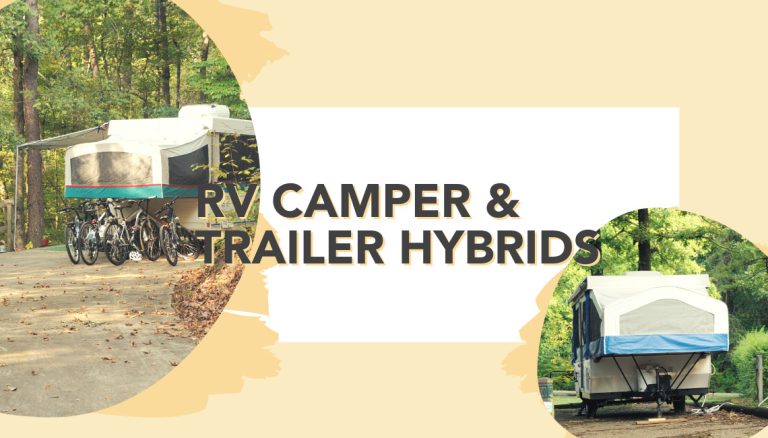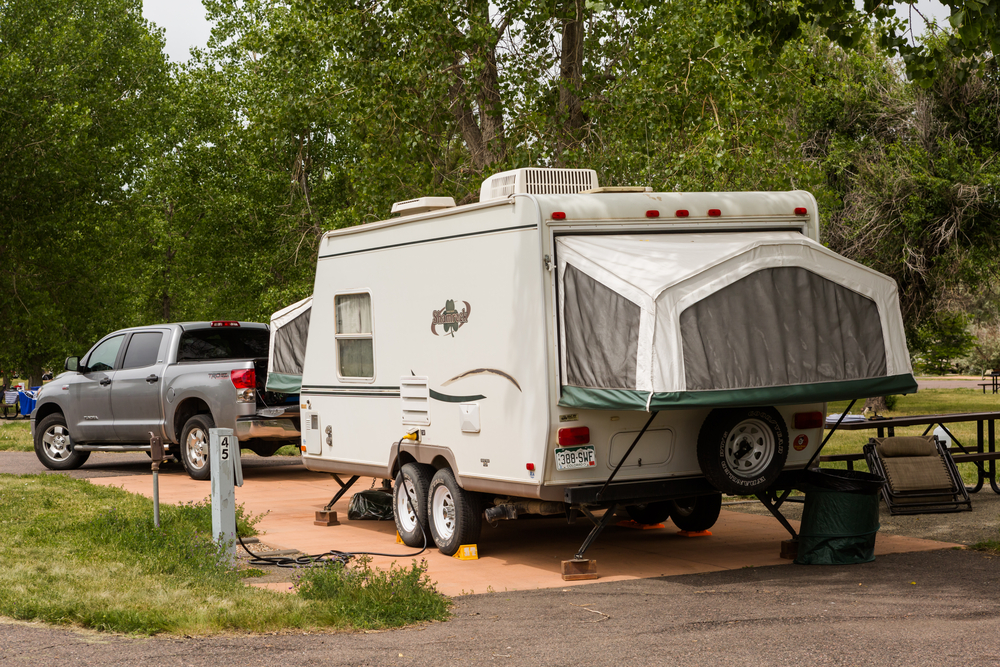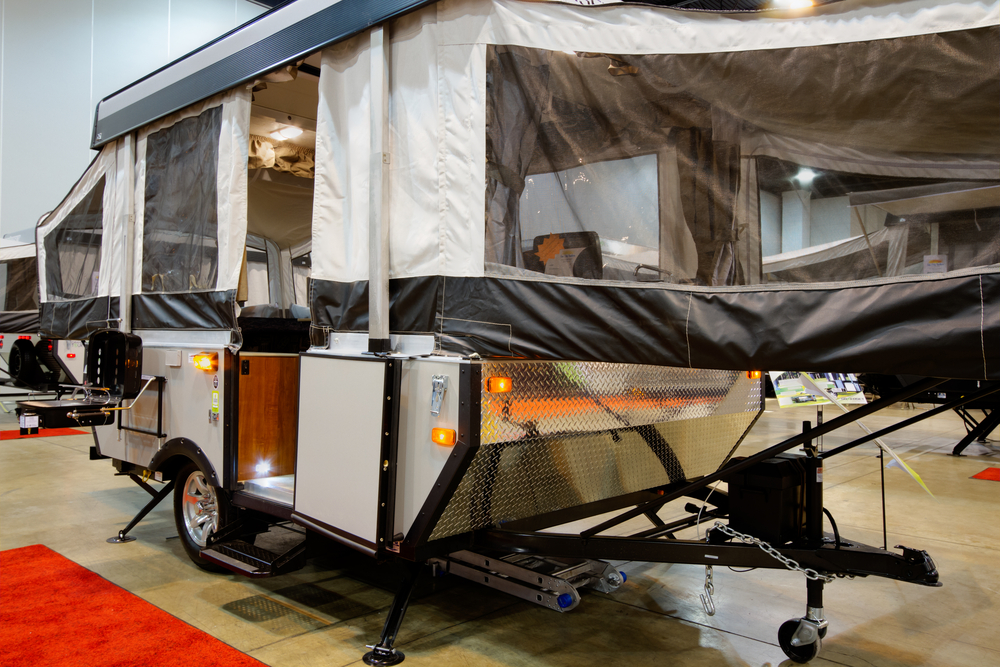

What is a Hybrid RV?
Hybrid campers are an interesting breed, for sure. A cross between a pop-up camper and a traditional bumper-pull travel trailer, these awesome RVs include a hard body and roof, but have pop-outs made of canvas, giving the user more interior space to work with without the added length or weight. They are lightweight, spacious, and perfect for many camping families.
Hybrid trailers first hit the market in the late 1990s. Because they’re a relatively new addition to the RV market, they are often left out of RV type lineups, and some people are completely unaware they even exist. This is unfortunate because the hybrid RV fills a void that no other camper can, meaning they might make camping possible for people who believe an RV is out of reach for them due to their vehicle type and/or the number of people in their family.

Benefits of a Hybrid RV
There are many reasons to choose a hybrid camper. In fact, for many, these “crossover” RVs check a variety of boxes that no other RV type can check off, making it a no-brainer to purchase one.
Wondering what benefits a hybrid travel trailer might provide? Below are some of the biggest benefits and most common reasons people end up choosing a hybrid over other types of RVs.
Weight, Length, and Space
If you’re looking for an RV that can fit the whole family but is still relatively easy to tow, a hybrid might be just the thing. They aren’t any lighter than hard-sided campers that match them in size when folded up. However, their pop-outs—which add hardly any weight—allow the camper to expand to a much bigger size once parked.
These pop-outs remove the need to have beds taking up valuable floor space, and offer more sleeping space than most other travel trailers, meaning you get more usable space in a smaller and lighter package that can be towed by a small truck or SUV.
Ease of Set Up
Unlike pop-up campers which can be a real pain to get set up, hybrid RVs are very simple to set up. The beds fold out very easily and can even be popped out by one person working alone, as long as that person is tall enough. Aside from this simple step, the rest of the setup process is identical to the process for a hard-sided camper.
Flexibility
While a pop-up camper must be completely set up before you can go inside, a hybrid RV can actually be used without popping out the beds. This is handy in a few instances.
For one, if you arrive at a campground after dark or in the middle of a rainstorm, it is possible to go straight inside without dealing with any outdoor setup.
Another time this might come in handy is if you stop to stay the night in a rest area or parking lot. In this case, you could leave the pop-outs in and instead sleep on the fold-out couch, or you can fold down the table bed.
Weather Protection
A hybrid travel trailer also offers more weather protection than a pop-up. While the tent-like pop-outs aren’t the best place to be when it’s very windy or rainy, these can be pulled in while you wait out the bad weather, and you will be left with a hard-sided camper that provides protection from the elements.
Cons of a Hybrid RV
What about cons? There are, of course, drawbacks to owning a hybrid trailer as well. While these can all be worked around, they are things that might make you think twice about purchasing a hybrid rather than a traditional hard-sided camper. This is especially true if you plan to live in your RV full-time, but these cons will affect you even if you only plan to use the rig on weekends.
Read on to learn the top three drawbacks of owning a hybrid pop-up camper.
Less Temperature Control
Unfortunately, the canvas pop-outs do let in the heat and cold, making it much more difficult to control the temperature in a hybrid camper. This is a bigger problem in extreme heat and extreme cold, and less of an issue in spring and fall or in places with mild weather year-round.
Leaking and Canvas Damage
Hybrid campers are also more prone to leaks than other types of campers. This is because the water tends to seep in around the canvas pop-outs. On top of that, canvas can be damaged relatively easily. Rips, holes, and mold are all things to look out for.
If you plan to purchase a used hybrid trailer, we recommend looking very carefully for problems with the canvas, as well as water damage around the pop-outs. Continue watching for these things once you own your hybrid, and you should be able to nip any problems in the bud.
Security Issues
While it isn’t something to worry about in most cases, hybrid campers do not offer the same sort of security hard-sided campers would. The fabric pop-outs could be cut, meaning someone could very easily enter your RV if they really wanted to.
That said, this is highly unlikely in most campgrounds, and even more so out in the wilderness. In fact, we’d say bears would be the bigger concern when boondocking, and those aren’t likely to bother you as long as you put food away properly.
More Noise
Finally, there is the noise issue to contend with. Because canvas does nothing to block out sound, you can pretty much count on listening clearly to anything happening outside.
Again, if you’ll be camping in the middle of nowhere, this isn’t really a concern, but those staying in busy campgrounds might have a problem with this, especially if they camp with small children who go to bed earlier in the evening.

Hybrid RV Interiors
If you’ve never had the opportunity to step foot in a hybrid RV, you may be wondering what you might expect the interior to look like. The answer? For the most part, these unique trailers look much like their hard-sided camper cousins. They feature a kitchen area, a dinette for eating, and some have a couch. A bathroom is present—though a wet bath is sometimes used to save space—and a few hybrid campers even feature slide-outs, adding more living space.
Quite possibly the only noticeable difference between a hybrid and a traditional trailer is the presence of the aforementioned canvas pop-outs. In most cases, these pop-outs are on one or both ends of the RV, but they can also be present on the side of the trailer.
The pop-outs contain beds that fold down out of the wall, creating a small, tent-like structure where the bed lives when in use. When the bed is folded in, it is flush (or nearly flush) with the rest of the wall. This means that unlike a slide-out, a pop-out will not eat up your floor space when pulled in, but you will not be able to use the bed with the pop-out in this position.
Hybrid RV Exteriors
The exterior of a hybrid trailer is also very similar to that of a hard-sided bumper-pull trailer. It has four hard-sided walls, a rubber roof, and one or two axles, depending on the size of the trailer. You’ll also find all the same hookups, meaning you can have electricity, water, and sewer in your tiny home-on-wheels, just as you would in a traditional trailer or motorhome.
Again, the difference is all in those canvas pop-outs. From the outside, these pop-outs look like small tents attached to the sides of the trailer when folded down. When folded up, they appear to be doors or slide-outs of some sort, and are flush with the hard-sided exterior walls.
Some people may be completely unaware of the fact that a trailer is a hybrid until those pop-outs are folded down.
How Much Does a Hybrid RV Cost?
While pop-up campers are much cheaper than hard-sided trailers, hybrid campers tend to cost about the same as their traditional counterparts. That is to say, an 18-foot hybrid camper would be priced in the same ballpark as an 18-foot hard-sided camper.
That said, because of their pop-out beds, hybrid campers actually give you more bang for your buck in terms of sleeping space and floor space. Those beds folding out of the wall can easily turn your 18-foot trailer into a 26-foot one without any added weight or cost. In this sense, though it may not seem like it at first glance, a hybrid RV offers excellent value.
Want to find the cheapest hybrid out there? Expect to pay around $18,000 for the least expensive models. Meanwhile, those looking to go big will shell out around $40,000 for the biggest and fanciest hybrid campers there are.
What is the Lightest Hybrid Camper?
If you’re looking into purchasing a hybrid pop-up camper, chances are you’re doing so to sleep several people in the lightest possible trailer. Therefore, it only makes sense that many people are wanting to know about the weight of these campers.
Generally speaking, a hybrid RV will weigh between 3,000 and 7,000 lbs. Of course, the final weight depends on the length of the trailer, whether it includes a slide-out, what kinds of appliances and amenities are packed inside, and how much stuff you pack into it.
If you are looking for a super light hybrid, something like the inTech Flyer Explore may be your cup of tea. Just be aware that the cargo carrying capacity on the smallest and lightest hybrid trailers is very low, making it difficult to pack everything a family might need on a camping vacation.
As you can see, hybrid campers are a very unique type of RV that can serve a niche audience very well. If you think a hybrid might be the right choice for you but want to try one out first, considering renting before buying.
We have plenty of hybrid campers available right here on RVshare, so finding something to suit your needs shouldn’t be an issue at all.
